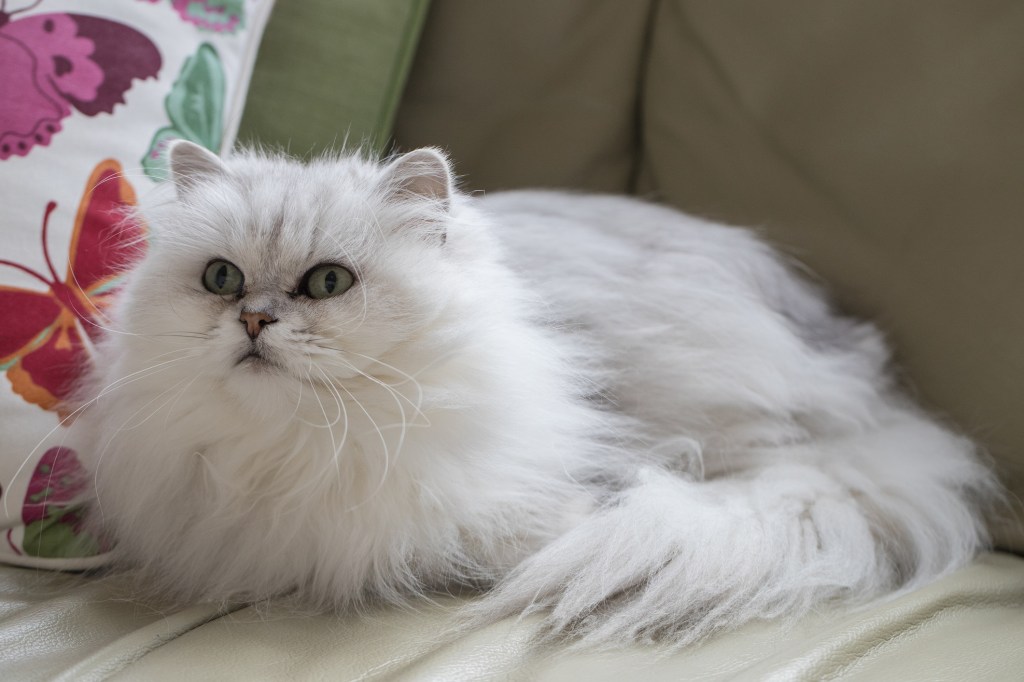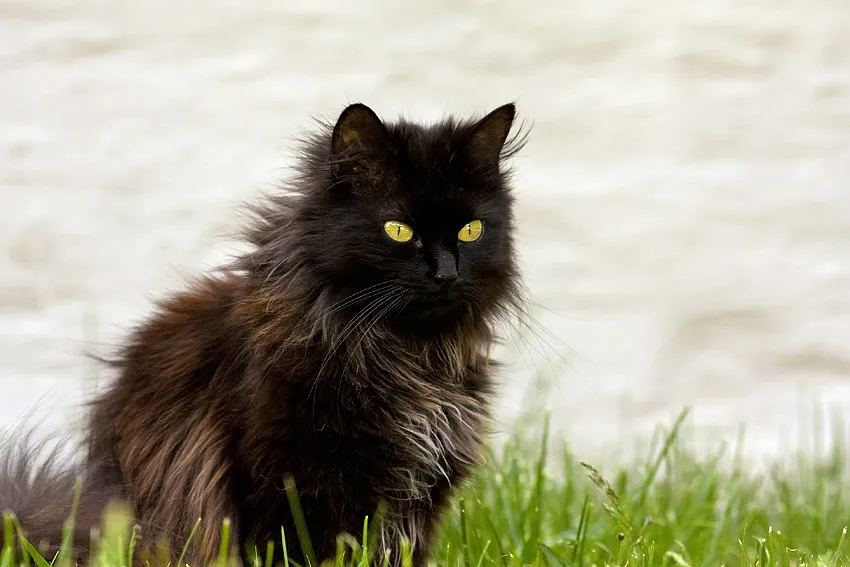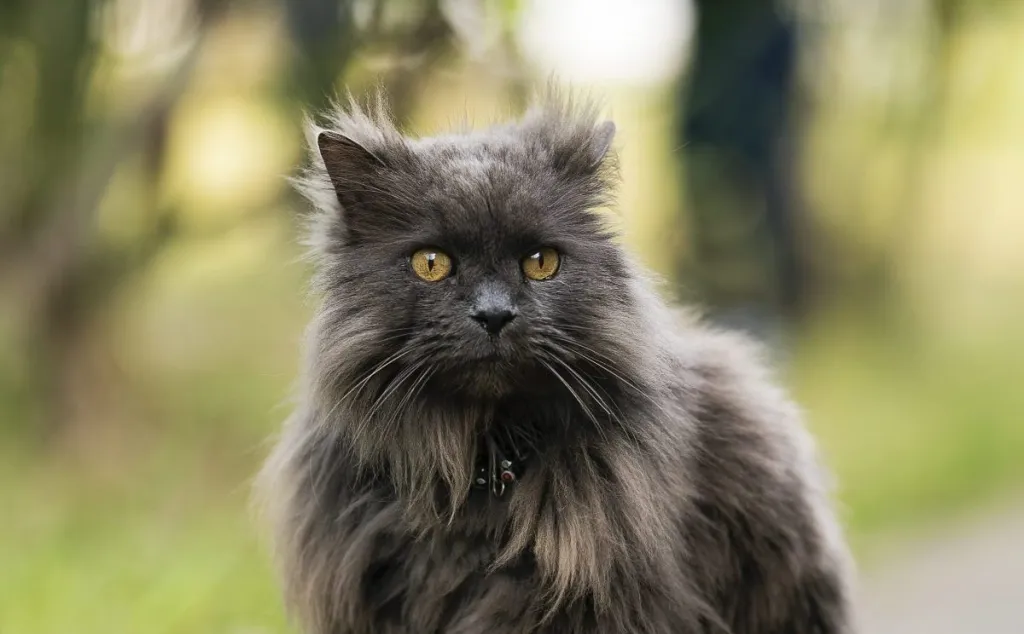The Chantilly-Tiffany cat, also known as the Tiffany or Chantilly, is a now-extinct breed once loved for their affectionate temperament and striking appearance. These cats originated in the United States sometime in the 1960s. Look at their luxurious coat, golden eyes, and high cheekbones, and you’ll understand why they earned the nickname “supermodel of the cat world.” For a moment, Chantilly-Tiffany cats were very popular but had difficulty taking off and faced extinction multiple times. Sometime in the 1980s, they nearly went completely extinct. By the early 2000s, the breed had made a slight comeback.
The Chantilly-Tiffany cat has a medium—to large-sized body. Their silky soft coat comes in various colors, including chocolate, blue, cinnamon, and fawn. Beyond their dynamic appearance, the Chantilly-Tiffany cat breed is also known for their affectionate personality. Chantilly-Tiffanys make wonderful companions and are less independent than other breeds. Highly personable, the Chantilly cat is sometimes even described as being dog-like. They are also said to be laid-back and calm. While they may be initially reserved with strangers, these sweet kitties tend to warm up quickly.
Because of the breed’s rarity and the lack of official breeding programs, be highly cautious of breeders claiming to promote Chantilly-Tiffany kittens for sale. There are no known Chantilly-Tiffany breeders. If you do find one, do your research! There isn’t much information on the Chantilly-Tiffany cat price due to their extinct status, and it’s possible that some scams might try to take advantage of this lack of information. There are plenty of other wonderful cat breeds in need of adoption from rescue organizations or shelters. Every year, millions of cats in shelters face euthanasia. You can make a difference by providing a loving home to a cat in need.
Quick Facts
- Origin: United States (1969)
- Size: Medium (8-12 pounds)
- Breed Group: Longhair
- Lifespan: 14-16 years
- Coat: Semi-long or long, silky, and luxurious, with a stunning chocolate brown color and silver tipping on the chest, belly, and legs.
- Temperament: Intelligent, playful, affectionate, loyal, gentle, and calm. They are often described as having a dog-like personality.
- Exercise Needs: Moderate – enjoys playtime but can also be content lounging.
- Training: Easily trainable due to their intelligence and desire to please.
- Grooming: Weekly brushing to prevent matting.
- Health: Generally healthy but prone to some genetic health conditions
- Sadly, since 2012, the Chantilly-Tiffany cat breed has been considered extinct due to the lack of an active breeding program. It is assumed there are still Chantilly-Tiffany cats, although they are rare. The last cattery burned down in a fire in 2012.
- As they age, their eyes deepen in color.
- These cats are moderately active, neither being too lazy nor too energetic.
Chantilly-Tiffany Pictures


-
Affectionate with Family
Some cat breeds are typically independent and aloof, even if they’ve been raised by the same person since kittenhood; others bond closely to one person and are indifferent to everyone else; and some shower the whole family with affection. Breed isn’t the only factor that goes into affection levels; cats who were raised inside a home with people around feel more comfortable with humans and bond more easily.

See Cats Less Affectionate with Family -
Amount of Shedding
If you’re going to share your home with a cat, you’ll need to deal with some level of cat hair on your clothes and in your house. However, shedding does vary among the breeds. If you’re a neatnik, you’ll need to either pick a low-shedding breed or relax your standards. This furniture cover can make it easier to clean up cat hair and keep it off your sofa!
-
General Health
Due to poor breeding practices, some breeds are prone to certain genetic health problems. This doesn’t mean that every cat of that breed will develop those diseases; it just means that they’re at an increased risk. If you’re looking only for purebred cats or kittens, it’s a good idea to find out which genetic illnesses are common to the breed you’re interested in.
-
Potential for Playfulness
Some cats are perpetual kittens—full of energy and mischief—while others are more serious and sedate. Although a playful kitten sounds endearing, consider how many games of chase the mouse-toy you want to play each day, and whether you have kids or other animals who can stand in as playmates. A classic wand cat toy like this one is perfect for playful felines!
-
Tendency to Vocalize
Some breeds sound off more often than others with meows, yowls, and chattering. When choosing a breed, think about how the cat vocalizes and how often. If constant “conversation” drives you crazy, consider a kitty less likely to chat.
-
Kid-Friendly
Being tolerant of children, sturdy enough to handle the heavy-handed pets and hugs they can dish out, and having a nonchalant attitude toward running, screaming youngsters are all traits that make a kid-friendly cat. Our ratings are generalizations, and they’re not a guarantee of how any breed or individual cat will behave; cats from any breed can be good with children based on their past experiences and personality.
-
Friendly Toward Strangers
Stranger-friendly cats will greet guests with a curious glance or a playful approach; others are shy or indifferent, perhaps even hiding under furniture or skedaddling to another room. However, no matter what the breed, a cat who was exposed to lots of different types, ages, sizes, and shapes of people as a kitten will respond better to strangers as an adult.
-
Easy to Groom
Some breeds require very little in the way of grooming; others require regular brushing to stay clean and healthy. Consider whether you have the time and patience for a cat who needs daily brushing. You should definitely pick up this awesome de-shedding tool for cats of any hair length!
-
Intelligence
Some cat breeds are reputed to be smarter than others. But all cats, if deprived the mental stimulation they need, will make their own busy work. Interactive cat toys are a good way to give a cat a brain workout and keep them out of mischief. This scratcher cat toy can keep your smart kitty busy even when you’re not home!
-
Pet Friendly
Friendliness toward other household animals and friendliness toward humans are two completely different things. Some cats are more likely than others to be accepting of other pets in the home.
Chantilly-Tiffany Cat History
Chantilly-Tiffany Cat Size
The Chantilly-Tiffany is a medium-sized cat. As is always the case, exact size standards might vary. Most Chantilly-Tiffanys weigh between six and twelve pounds. However, many can be smaller or larger than average.
Chantilly-Tiffany Cat Personality
The Chantilly-Tiffany is super lovable and very devoted to the humans in their life. This is a breed of cat that always wants to be around human company, so don’t be surprised if the cat happily follows you around from room to room, whether you’re cooking in the kitchen, relaxing on the couch binge-watching a TV series, or napping in the bedroom.
The Chantilly-Tiffany also has a reputation as a vocal feline. They’ll happily talk to you throughout the day, so be prepared for some cat chat! Beyond the breed’s affectionate side, they also showcase a playful streak. Make sure you have a solid selection of toys in rotation, and consider adding smart, interactive toys to the living environment.
Chantilly-Tiffany Cat Health
Chantilly-Tiffanys are generally considered to be healthy cats; although it’s important to schedule regular wellness visits with your cat’s vet. Some of the more common health problems Chantilly-Tiffanys suffer from include:
- Digestive issues: Digestive issues in cats can arise for various reasons and may manifest in a range of symptoms. Cats may vomit occasionally due to reasons such as hairballs, eating too quickly, or consuming something indigestible. However, persistent or frequent vomiting could indicate underlying issues such as infections, food allergies, or gastrointestinal disorders.
- Obesity: Obesity in cats is a common and concerning health issue that can lead to various health problems and reduce the overall quality and length of a cat’s life. Several factors contribute to obesity in cats, and addressing these factors is crucial for the cat’s well-being.
Chantilly-Tiffany Cat Care
As with all cats, it’s important to keep up your Chantilly-Tiffany’s regular veterinary checkups to detect any health concerns early. Your vet can help you develop a care routine that will keep your cat healthy.
Beyond scheduling yearly wellness visits with your vet, make sure that you pick up a scratching post for your Chantilly-Tiffany cat’s living environment. This can help promote healthy scratching and keep the cat’s nails in good condition. The Chantilly-Tiffany’s ears should be examined regularly for signs of dirt building up or possible infection.
Talk to your vet about starting a regular teeth brushing regimen that will suit your Chantilly-Tiffany. Your vet can advise you about specific brands and techniques. Finally, the Chantilly-Tiffany is a cat breed that will appreciate a cat tree to play and interact with. This will help keep the cat active and physically satisfied, so definitely consider adding one to your home!
Chantilly-Tiffany Cat Coat Color And Grooming
The Chantilly-Tiffany was originally found sporting a distinctive chocolate brown colored coat, and many still do; although they’re also now found in other shades. The coat is considered semi-longhaired.
When it comes to grooming a Chantilly-Tiffany, ideally you will want to make time to schedule brushing daily sessions. This will help keep the cat’s semi-long coat in good condition and also ward off the chances of mats forming. Use the grooming time as an opportunity to bond with your feline.
In terms of climate, most Chantilly-Tiffanys are fairly adaptable. Just remember to always make sure that there’s enough shade and fresh water available during the hotter months.
Children And Other Pets
The Chantilly-Tiffany is normally a very good fit for families with young kids. Just make sure that early socialization takes place and boundaries are properly set on both sides. Supervise early interactions between young children and cats.
When it comes to other household pets, the Chantilly-Tiffany usually fares well with most other domestic animals. But always make sure to supervise early interactions between the new cat and existing pets. Sometimes these relationships are very much dependent on the individual pets’ personalities.
Ultimately, early socialization really pays off with this breed. Make sure to reward your Chantilly-Tiffany for good behavior when you bring them home to your family!
Chantilly-Tiffany Cat Rescue Groups
It may be hard to find a breed specific rescue for Chantilly-Tiffany cats. However, you may want to try shelters and rescues that cater to all types of cats, including Chantilly-Tiffany cats, as well as your local shelter. These cats are extremely rare, and the breed is near extinction. Here are some nonprofit rescues you can try:
More Info For You
If you’re also looking for a dog, check out DogTime’s dog breed page!





